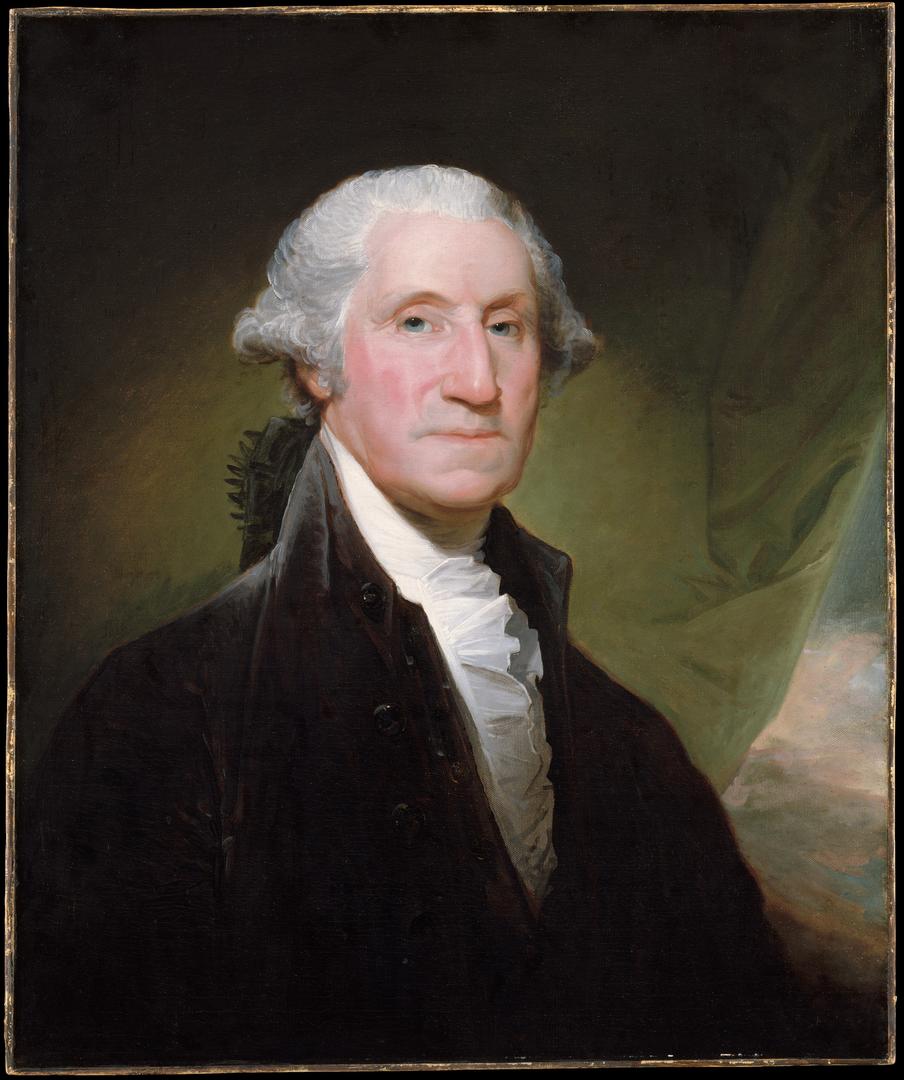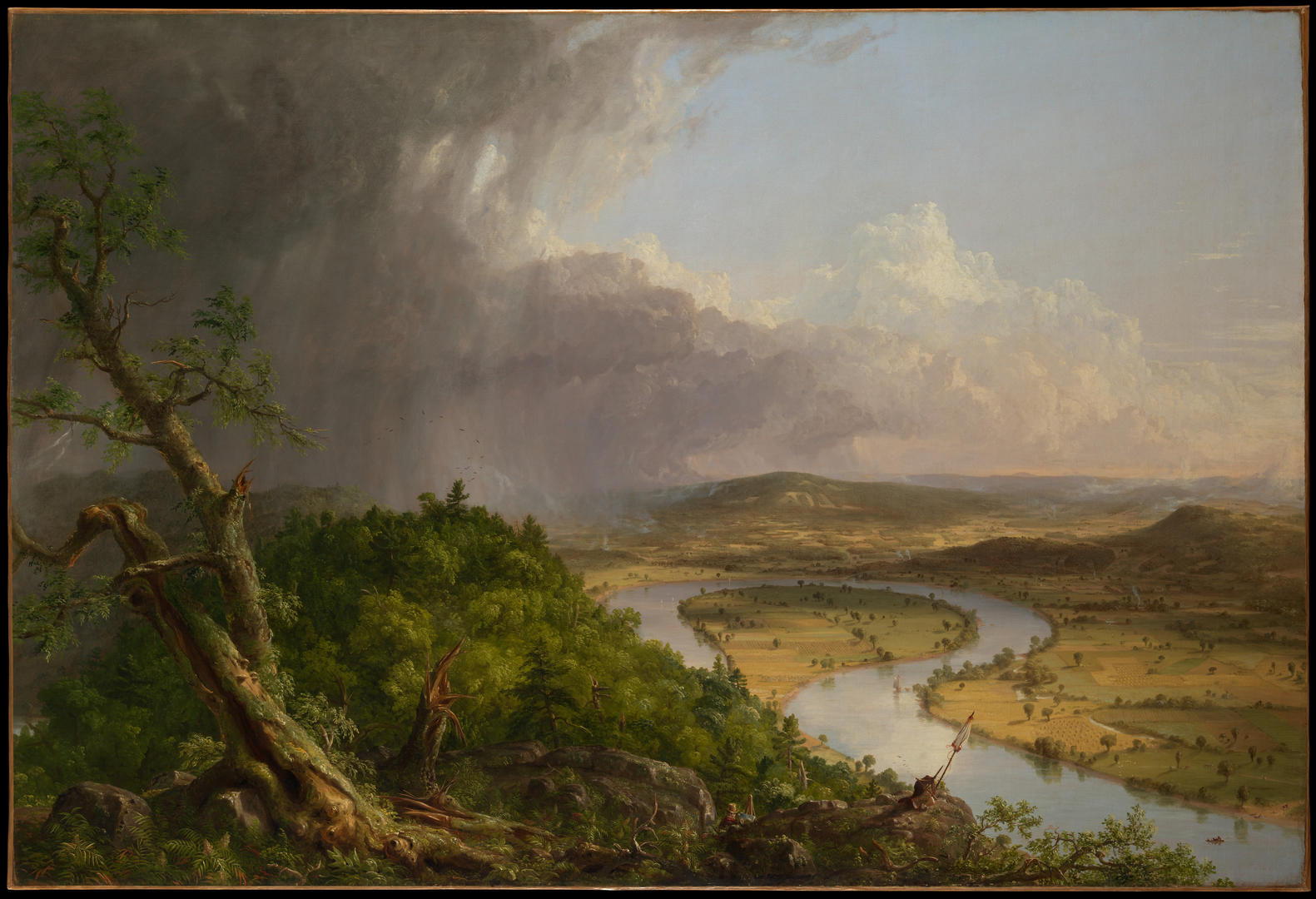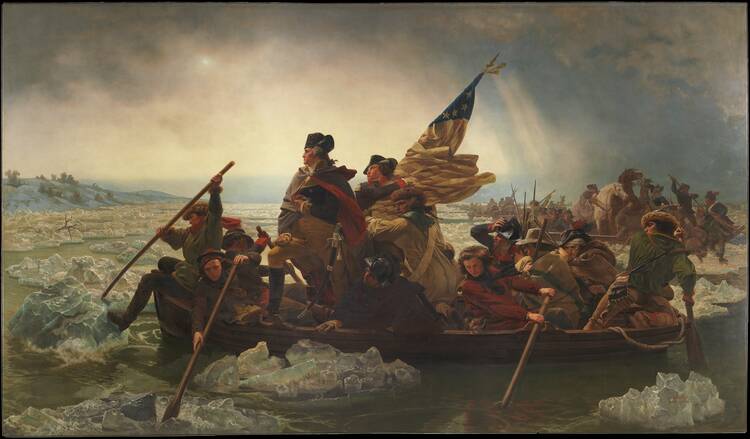In 1864 a Metropolitan Fair, organized by the United States Sanitary Commission, was held in New York City in support of the Union Army. Three great paintings now in the collection of the Metropolitan Museum of Art in New York were especially admired. The largest by far was Emanuel Leutze’s “Washington Crossing the Delaware” (10’ by 21’) from 1851, which depicted George Washington’s crucial crossing of the Delaware River on Dec. 25, 1776, for a successful surprise attack on the Hessian encampment just north of Trenton, N.J.
Admired as well were two grand landscapes, Frederick Edwin Church’s “Heart of the Andes,” from 1859, and Albert Bierstadt’s “Rocky Mountains, Lander’s Peak,” from 1863, each roughly 6’ by 10’. The combined effect was heroically patriotic—America taking its place in the world—and with the rest of the fair raised more than $1 million dollars for the Union.
Leo. J. O’Donovan, S.J., makes a virtual visit to the American Wing of the Metropolitan Museum of Art in New York.
On this Fourth of July we Americans, beset by a world-wide, deadly pathogen, suffering from severe economic distress and newly, painfully aware of our heritage of racial injustice, need new reasons for patriotism. But not just any patriotism. “Patriotism,” Mark Twain famously said, “is supporting your country all the time, and your government when it deserves it.” Centuries before, in his treatment of piety as a special virtue, St. Thomas Aquinas included patriotism as part of our indebtedness to “our parents and our country [patria] who have given us birth and nourishment.” Immanuel Kant’s 1795 influential essay “Perpetual Peace” proposed a “cosmopolitan right” based on the principle that all human beings are equal members of a universal community. But he held that the delusion that one’s own nation is superior to others must be “eradicated “ by patriotism and cosmopolitanism as two sides of one coin. “World patriotism and local patriotism,” he argued, are both required of the cosmopolitan. (The term itself derives from Diogenes the Cynic, of the fourth century B.C.)
What does it mean today to be patriotic? The discussion is more fraught than one might imagine, ranging from Leo Tolstoy, who thought it both “stupid and immoral,” to George Orwell, who was particularly concerned with the dangers of nationalism—which he thought an aggressive search for power contrasted with patriotism’s defensive posture of protecting one’s own land and culture—to the elegant contemporary position of Kwame Anthony Appiah, who proposes a “rooted [in one’s own country] cosmopolitanism.” Various scholars have distinguished: extreme patriotism (“My country, right or wrong”); moderate patriotism (for which it is almost the bedrock of a shared morality); and ethical patriotism (a special concern for the moral identity and integrity of one’s country). For our purposes here, let’s take the ordinary dictionary definition, “love of one’s country,” and express it somewhat more fully, with the Stanford Encyclopedia of Philosophy, as love of one’s country, identification with it and special concern for its well-being and that of compatriots.

For evidence of patriotism then, let’s make a virtual visit to the American Wing of the Metropolitan Museum of Art in New York. We’ll be on the lookout for patriotism that we can be proud of—not the kind of nationalism that betrays the true ideals of the country.
In the very first galleries, colonial portraiture shows emerging pride in the country, with John Smibert presenting “Mrs. Francis Brinley and Her Son Francis” in 1729 as a kind of colonial Madonna and Child. In 1765 Matthew Pratt painted “The American School,” a scene from Benjamin West’s London studio, featuring West himself presiding (he had moved to England in 1763) and Pratt at the easel. But it was West’s almost exact contemporary John Singleton Copley who above all showed to the Colonies on the verge of the Revolution the values and hopes of such worthies as the wealthy Boston merchant “Joseph Sherburne” (c. 1767-70) and “Mrs. John Winthrop” (1773), above a beautifully reflective table top, with her knowing slight smile—each painting a paean to assured, self-confident New World citizens.
In the era of the Revolution the greatest interest was predictably in its emerging leaders. John Trumbull portrayed George Washington in 1780 on a bluff above the Hudson River, with his enslaved personal servant, Billy Lee, on horseback behind him. Charles Wilson Peale, founder of one of the country’s first museums, in Philadelphia, portrayed many historic figures of the period—Benjamin Franklin, John Hancock, Thomas Jefferson and Alexander Hamilton among them. But images of our first president were most in demand; and in one of his close to 10 portraits of Washington, Peale depicts him full-length as the victor of the Battle of Trenton, in military dress and wearing his state sword (c. 1779-81). Gilbert Stuart nevertheless took the palm and became the leading portraitist of the period. He painted over 1,000 individuals and, after careful planning, managed in 1795 to have the 63-year old president sit for him. In the Met we see one of his many subsequent portraits of Washington, this one a bust-length piece known as the Gibbs-Channing-Avery portrait. His George Washington became ours also. (Stuart went on to paint the next five presidents as well.)

In the next century Americans wanted to know what ordinary life in their country was like, and the genre paintings in the Met’s two galleries on “Life in America” from 1830 to 1880 introduce us to the dignity but also the disgraces of everyday life. An unknown artist shows us the latter vividly in “The Five Points” (c. 1827), depicting a slum on the Lower East Side of Manhattan that The New York Herald declared a “nest of drunkenness, roguery, debauchery, vice, and pestilence,” home to the city’s poorest citizens, including new immigrants, unskilled laborers and African-Americans. In “Cider Making” (1840-41), William Sydney Mount shows a warm, seemingly innocent moment in rural life that was actually inspired by the political intrigue around the presidential election of 1840, in which the populist Whig candidate, William Henry Harrison, was running against the purportedly elitist Democrat, Martin Van Buren. Mount’s geometric composition and luminist light recur in George Caleb Bingham’s “Fur Traders Descending the Missouri” (1845), a still, solemn scene that immortalizes the lost world of the American frontier, to the fascination of its Northeastern audience. Lily Martin Spencer, the one woman painter to gain (considerable!) fame in the antebellum country, specialized in charming domestic scenes but also painted such prominent figures as the suffragist Elizabeth Cady Stanton. And Francis William Edmonds’s “Taking the Census” (1854) combines a humorous family scene with a small portrait of George Washington above the mantel and a father puzzled about his family statistics, all within a recollection of the United States Census of 1850.
Grandeur was of still greater interest, and it was provided by what the title of an exhibition 20 years ago at the Met called “American Paradise: The World of the Hudson River School.” Thomas Cole was the founder of the school, and its theme was the American landscape as filled with God’s presence and revealing the “Manifest Destiny” of the new republic. Born in England in 1801, Cole emigrated with his family in 1816 to the United States, where he lived until an early death in 1848. In “View from Mount Holyoke, Northampton, Massachusetts, after a Thunderstorm—The Oxbow” (1836) he set the standard for American landscape, sublime in its moral import. If read from left to right the painting can be read as hopeful, as threatening if read from right to left. Portraying himself in the lower right foreground of the picture, Cole was at once proclaiming the unique promise of America and the threat to its natural beauty posed by impending industrialization.
Asher Brown Durand succeeded Cole as the leader of the school, and his more naturalistic, tranquil style shines in “The Beeches” (1845). The school’s more ambitious vision was evident in his contemporaries Frederick Edwin Church, who had studied with Cole, in his epic “Heart of the Andes” (1859), and the German-born Albert Bierstadt, who staked out the American West as his theme, in the soaring, heroic “Rocky Mountains, Lander’s Peak” (1863). (The Bierstadt includes in the foreground a Shoshone village full of peaceful family life that the artist himself thought likely doomed.) Among other, later Hudson River painters were artists for whom light became their very theme—Sanford Robinson Gifford, whose “A Gorge in the Mountains (Kauterskill Clove)” (1862) daringly takes an empty space in the middle of the painting and fills it with golden light; Fitz Henry Lane, whose “Stage Fort across from Gloucester Harbor” (also 1862) is the very apotheosis of New England maritimes; and John Frederick Kensett, perhaps the prince of luminists, whose late “Eaton’s Neck, Long Island” (1872) is luminescent simplicity well ahead of its time.

I thought I knew Martin Johnson Heade’s “Approaching Thunder Storm” (1859) by heart. The smoking man and his dog on the crescent beach, the little boy rowing toward them, the looming inky clouds covering the whole top of the painting: I knew it was a painting not only about a particular storm but about unpredictable threats in life more generally. But I had not connected it to Lincoln’s repeatedly speaking of “the storm coming” in his 1860 campaign. Nor that it was first owned by the Rev. Noah Hunt Schenck, an ardent abolitionist at Baltimore’s Emmanuel Episcopal Church. Nearby is Gifford’s “A Coming Storm” (1863), a somber view of Lake George quite unlike his more typical atmospheric views in golden light. When Herman Melville saw it exhibited after Lincoln’s death, he wrote of “the demon cloud.”
Our greatest test of patriotism came—at the cost of 700,000 lives—with the Civil War. Winslow Homer, embedded at the front in Virginia for Harper’s Weekly, became its chronicler and probed the war’s meaning and toll in “The Veteran in a New Field” (1865), a sublimely simple meditation on what might lie ahead, and “Prisoners from the Front” (1866), a scene of surrender that quietly implied how difficult any true reconciliation would be. A decade later, after the failure of Reconstruction, Homer’s sympathy for all fellow Americans is liltingly evident in “Dressing for the Carnival” (1877), which depicts a Christmas holiday celebration formerly observed by enslaved blacks in Virginia and North Carolina that was then transformed into African-American Independence Day celebrations. (The painting’s original title was “Sketch—4th of July in Virginia.”) Nearby is a bronze statuette reduction of John Q. A. Ward’s extraordinary “The Freedman,” a powerful, seminude African-American man holding the broken manacles of his former enslavement. (Ward made it in 1863, the year after Lincoln’s “Emancipation Proclamation.”) Lincoln himself—to the great pride of the Met, which acquired the piece in 2012, just before the new American Wing opened—is here as well, standing deep in thought before a chair of state in a bronze statuette that was cast in 1911 from Augustus Saint-Gaudens’s magnificent “Lincoln Standing,” created for Chicago’s Lincoln Park in 1887.
In the later 19th century Homer and his slightly younger contemporary, Thomas Eakins, were the most prominent of American painters, Eakins working especially in his home city of Philadelphia, Homer traveling the northeast coast and the Caribbean, until he moved to Prouts Neck, Me., in 1883. Together they charted the life of Americans in the increasingly urbanized and expanding society that developed after the war. (The population almost tripled, not least through the waves of immigrants who came to our shores). Eakins’s “The Gross Clinic” (1875), considered by many to be the greatest American painting of the century, is in Philadelphia. But the Met has some of his finest work, including the incisively realistic “The Champion Single Sculls (Max Schmitt in a Single Scull” (1871), which appears to be simply one of the artist’s great early sports scenes but also comments quietly, through the steamer on the river and the train smoke on the trestle bridge, on burgeoning industrialization. Homer, in late paintings such as “The Gulf Stream” (1899), continued his sympathetic treatment of African-Americans (one critic has called the painting “the masterpiece of the black image”) but turned more and more to seemingly straightforward but in fact carefully composed reflections on the fierce beauty and power of the sea—“Northeaster” (1895, 1900) being a particularly compelling example.
Thomas Eakins’s “The Thinker” (1900) stands with his head bowed in thought, asking—one might say—“What now, America?”
There are further chapters of our history imagined in later galleries of the American Wing—evocations of the West (including sorrowful awareness of the decimation and relocation of native peoples), the rise of a cosmopolitan spirit, increasingly prominent images of women, America’s infatuation with French art evident in its own version of Impressionism, portraiture in the grand manner by John Singer Sargent, James McNeill Whistler and William Merritt Chase. A final gallery introduces the urban realism of the Ashcan School. And just before that hangs one of the Wing’s finest—and most reflective—paintings: Thomas Eakins’s “The Thinker” (1900), a tall painting of a very ordinary man (his otherwise scarcely known brother-in-law, Louis N. Keaton), who stands with his head bowed in thought, asking—one might say—“What now, America?”
What of George Washington’s servant Billy Lee? What of the African-Americans in Homer’s Fourth of July scene in Virginia? What of John Ward’s Freedman? Or of the millions of Native Americans driven from their sacred homelands? How can we be patriotic on this Fourth of July?
Let’s go back to what Emanuel Leutze painted in Düsseldorf in 1851, his “Washington Crossing the Delaware,” that he expected indeed to be successful in America but first of all painted as an encouragement to the liberal revolutionaries of Germany in 1848. The enormous painting is preposterous in some ways: the flag carried by (improbably) James Madison was not yet used at the time of the expedition; Washington himself should look considerably younger; the scene is set at dawn but actually took place at night; the river is less like the Delaware than the Rhine; it is doubtful that Washington, Madison and others could be standing in the shallow boat they are in.
Nevertheless: the scene is awesome, inspiring, thrilling—and cannot but evoke genuine patriotism. Not only because the whole endeavor was all but an act of desperation by a young general leading demoralized troops to rescue, if they could, the Revolution. But also because of who was daring to cross the icy river, ultimately for the pursuit of “life, liberty and the pursuit of happiness.” Look closely: Western frontiersmen guide the boat, a man wearing a Scottish hat rows on one side of the boat, an African-American on the other; we see also a French Canadian fur trapper, farmers and a Native American—and very likely (the figure in red) a woman representing all the other women without whom we could not have become free. The vision is not only of a stunning victory to come, giving us freedom—but of the marvelous variety of people who together pursued it.
If we could at least dream today of being so united, then wouldn’t we deserve to be called patriots?










